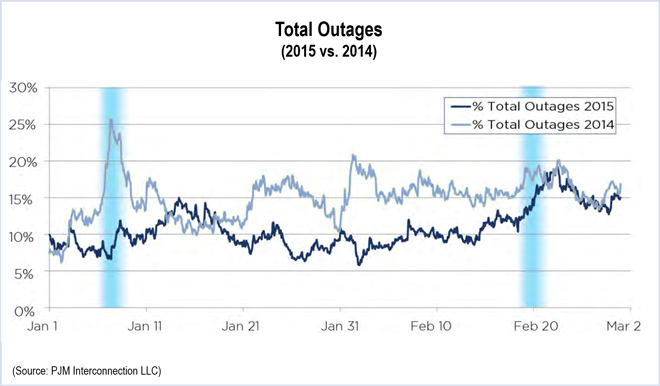By Suzanne Herel
VALLEY FORGE, Pa. — This winter bumped aside last year’s peak load record, but PJM’s system experienced a fraction of the stress brought on by the January 2014 polar vortex. Generator outage rates, which exceeded 20% in 2014, were generally less than 15% in 2015.
To figure out why, PJM researchers “did a deeper dive in different areas so we could understand the differences from last winter, and while we hit a new winter peak, why we did so much better,” Chantal Hendrzak, executive director for operations support, told the Operating Committee in presenting the 2015 Cold Weather Report.
Last year, recommendations for follow-up on winter preparedness filled pages. This year, there were five recommendations, all contained on one page.
A lot of the conversation, she said, revolved around whether this winter was colder, noting that it was most relevant to compare this past February with January 2014.
“We poked at weather in all sorts of different ways to understand what some of the differences were,” she said.
One of the findings was that while temperatures were colder this winter, the wind chill factors weren’t as severe in some areas. Including the wind chill factor, the low temperatures for Cleveland, Chicago and Columbus, Ohio, all were at least 14 degrees warmer this year.
Wind chill can have more of an impact — and more quickly — on generators than temperature alone, depending on how insulated they are and if the units are not enclosed in structures, she said.
Staff also looked at the days leading up to peak loads. This year, she said, “we kind of baby-stepped into the peak load” as opposed to the large incline seen before last year’s peak.
In addition, she said, wind capability increased over the previous winter.
This winter, she said, pipelines were more proactive in making sure pressure was maintained for their firm customers, generation owners took a number of precautions to ensure their availability and more units were running on alternate fuel.
In addition to PJM’s initiatives to introduce the Capacity Performance product and improve gas-electric coordination, the new report recommended continuing efforts to improve the ability of generators to communicate their operational parameters to grid operators; building on the testing program for seldom-run units and winter preparation checklist; and continuing efforts to reduce energy market uplift.
This winter’s success led a number of stakeholders to question the need for PJM’s new Capacity Performance product, which aims to strengthen reliability by penalizing underperforming units and rewarding overperforming participants. (See FERC OKs PJM Capacity Performance Proposal; Bay Dissents.)
Hendrzak said the changes the RTO saw this winter were voluntary. “PJM believes we need a more sustainable approach, so we are continuing to move forward with CP,” she said.


